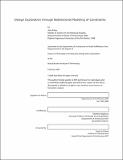| dc.contributor.advisor | Takehiko Nagakura. | en_US |
| dc.contributor.author | Kilian, Axel, 1971- | en_US |
| dc.contributor.other | Massachusetts Institute of Technology. Dept. of Architecture. | en_US |
| dc.date.accessioned | 2006-08-25T17:44:39Z | |
| dc.date.available | 2006-08-25T17:44:39Z | |
| dc.date.copyright | 2006 | en_US |
| dc.date.issued | 2006 | en_US |
| dc.identifier.uri | http://hdl.handle.net/1721.1/33803 | |
| dc.description | Thesis (Ph. D.)--Massachusetts Institute of Technology, Dept. of Architecture, 2006. | en_US |
| dc.description | This electronic version was submitted by the student author. The certified thesis is available in the Institute Archives and Special Collections. | en_US |
| dc.description | Includes bibliographical references (p. 315-324). | en_US |
| dc.description.abstract | Today digital models for design exploration are not used to their full potential. The research efforts in the past decades have placed geometric design representations firmly at the center of digital design environments. In this thesis it is argued that models for design exploration that bridge different representation aid in the discovery of novel designs. Replacing commonly used analytical, uni-directional models for linking representations, with bidirectional ones, further supports design exploration. The key benefit of bidirectional models is the ability to swap the role of driver and driven in the exploration. The thesis developed around a set of design experiments that tested the integration of bidirectional computational models in domain specific designs. From the experiments three main exploration types emerged. They are: branching explorations for establishing constraints for an undefined design problem; illustrated in the design of a concept car. Circular explorations for the refinement of constraint relationships; illustrated in the design of a chair. Parallel explorations for exercising well-understood constraints; illustrated in a form finding model in architecture. A key contribution of the thesis is the novel use of constraint diagrams developed to construct design explorers for the experiments. The diagrams show the importance of translations between design representations in establishing design drivers from the set of constraints. The incomplete mapping of design features across different representations requires the redescription of the design for each translation. | en_US |
| dc.description.abstract | (cont.) This redescription is a key aspect of exploration and supports design innovation. Finally, this thesis argues that the development of design specific design explorers favors a shift in software design away from monolithic, integrated software environments and towards open software platforms that support user development. | en_US |
| dc.description.statementofresponsibility | by Axel Kilian. | en_US |
| dc.format.extent | 324 p. | en_US |
| dc.format.extent | 110129897 bytes | |
| dc.format.extent | 110129695 bytes | |
| dc.format.mimetype | application/pdf | |
| dc.format.mimetype | application/pdf | |
| dc.language.iso | eng | en_US |
| dc.publisher | Massachusetts Institute of Technology | en_US |
| dc.rights | M.I.T. theses are protected by copyright. They may be viewed from this source for any purpose, but reproduction or distribution in any format is prohibited without written permission. See provided URL for inquiries about permission. | en_US |
| dc.rights.uri | http://dspace.mit.edu/handle/1721.1/7582 | |
| dc.subject | Architecture. | en_US |
| dc.title | Design exploration through bidirectional modeling of constraints | en_US |
| dc.type | Thesis | en_US |
| dc.description.degree | Ph.D. | en_US |
| dc.contributor.department | Massachusetts Institute of Technology. Department of Architecture | |
| dc.identifier.oclc | 70272308 | en_US |
